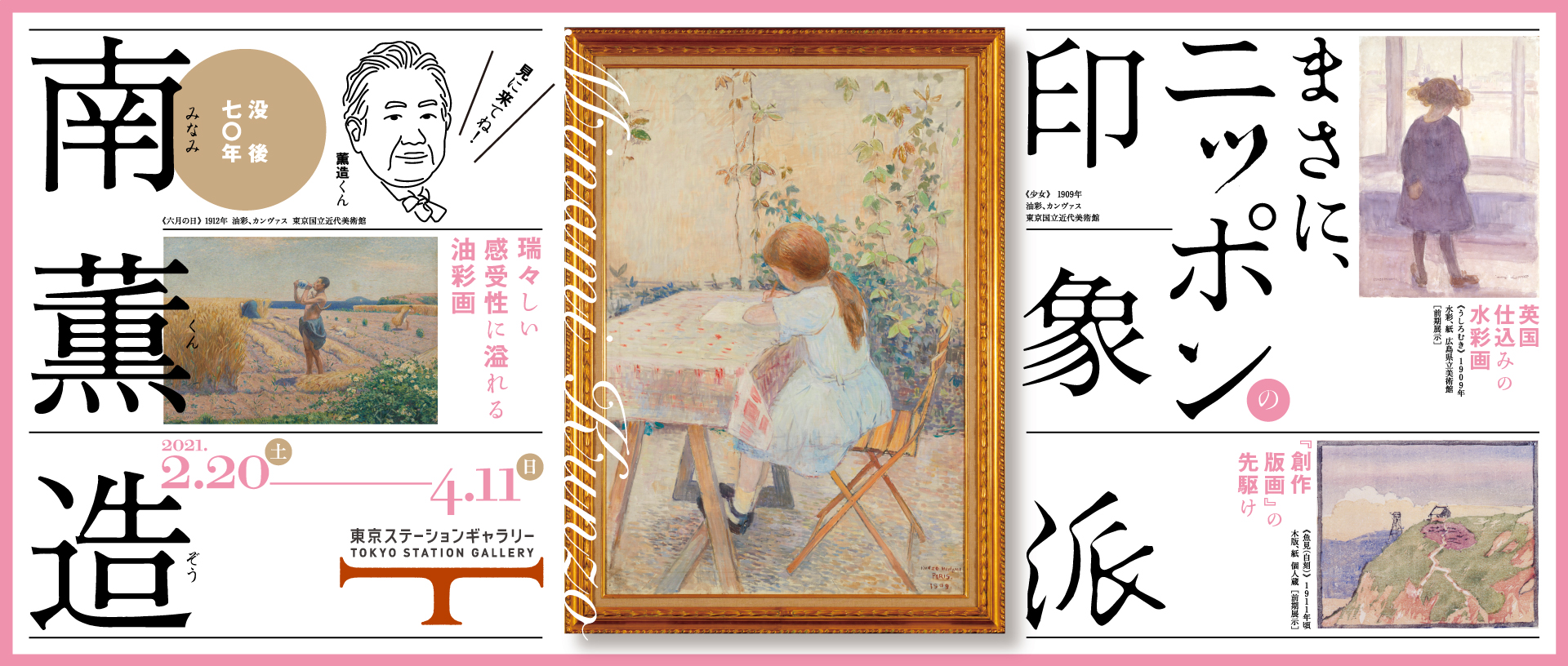
Minami Kunzo
Saturday, February 20 - Sunday, April 11, 2021
Tickets can be purchased from Lawson Ticket
- closed
- Mondays (except April 5)
- Opening Hours
- 10:00 a.m. to 6:00 p.m.
*Fridays: Until 8:00 p.m.
*Last admission 30 minutes before closing time
Outline
Why Minami Kunzo?
Many art exhibitions are held each year in Japan, attracting large audiences. In addition to large-scale Western fine art exhibitions, a number of exhibitions featuring Japanese art from eras such as the Edo Period (from the early 17th century to the late 19th century) and contemporary Japanese works have proven popular in recent years. Western-style paintings by modern Japanese artists have fallen through the cracks, and Tokyo Station Gallery has brought it back into the public eye by holding exhibitions exclusively in this genre since we reopened in 2012. We feel that it is a shame to see so many outstanding Western-style painters'work be forgotten, and know that great art does not need to be popular to make a deep impression on people.
Minami Kunzo (1883-1950) was a Western-style painter who was front and center at government-sponsored exhibitions in the early to mid-20th century. Studying in Great Britain at a young age, he was drawn to watercolors with a fresh style. On his return to Japan, he earned acclaim as an Impressionist, while also ushering in a new age of art in areas outside oil painting, with works such as woodcut prints in the sosaku-hanga (creative woodcut print) movement. Yet no major retrospective exhibitions of his work have been held outside his native Hiroshima, and his work is largely unknown.
This exhibition is the ultimate retrospective, providing an all-encompassing view of Minami's career. In addition to his best-known works that remain today, such as those that were featured in Bunten (Ministry of Education Art Exhibition), Teiten (Exhibition of the Imperial Academy of Fine Arts) and Nitten (Japan Art Exhibition), the exhibition features works such as watercolors that he painted while studying in Great Britain and woodcut prints that he created through his friendly rivalry with potter Tomimoto Kenkichi, a friend of his.
A fresh eye and outstanding technique
The appeal of Minami Kunzo's work lies in the fresh eye with which he captured landscapes and his neat depiction of people. There is nothing eccentric or showy about his works, yet there is a sense of peace and serenity in the fine-tuned way he expressed his fascination for nature that quickly earned him acclaim. That style is brought to life with an outstanding command of oil paint, transparently and delicately colorful use of watercolors and a well-defined composition in his woodcut prints. He was front and center at government-sponsored exhibitions for many years, and taught many new artists at the Tokyo Fine Arts School. His skill is unmistakable, even in the humblest of landscapes and the most unassuming of portraits.
A Japanese Impressionist
From his debut in the Hakuba-kai (White Horse Group) exhibition, a stronghold of pleinairists who specialized in depicting light, Minami Kunzo distinguished himself with his peaceful style featuring bright colors and soft brush strokes. This is most apparent in his oil paintings from around the time he studied in Europe, which embody the true essence of Japanese Impressionism. One Day in June, which appeared in the Sixth Bunten (Ministry of Education Art Exhibition), Minami skillfully captures a refreshing early summer scene in a farming village through techniques such as pointillism.
British-trained watercolors
Instead of studying in France, a popular destination for painters at the time, Minami Kunzo chose Great Britain. From the way Minami threw himself into watercolors during his time in Great Britain, it is clear that this was one of the reasons why he chose to study there. After all, Great Britain had produced many outstanding watercolor painters, such as Joseph Mallord William Turner. As Minami honed his skills in the home of watercolors, he developed a knack for capturing intricate patterns of light and subtle changes in color, all with a transparent look.
A pioneering figure in sosaku-hanga (creative woodcut print)
After returning to Japan, Minami Kunzo lived together with Tomimoto Kenkichi, whom he had become friends during his time in Great Britain and who would later become a prominent potter. The two artists worked on woodcut prints with a friendly rivalry. Their styles differed—Minami made landscapes while Tomimoto made patterns—but a point of commonality is that they both worked by themselves on the entire process from the rough sketch to the carving and printing stages. Minami and Tomimoto claimed self-drawing, self-carving and self-printing, and became pioneering artists in sosaku-hanga, an iconic movement in the early 20th century.
Free exploration in Minami's later years
In his later years, Minami Kunzo was forced to evacuate to the town of Utsumi in Hiroshima Prefecture due to World War II. There, he dedicated himself to his art, vividly capturing the Seto Inland Sea, scenery near where he was living and members of his family. His brush strokes are influenced by Fauvism, but are larger and more relaxed—his sheer love of painting shines through. These are oil paintings influenced by the climate in Japan at that time, paintings that encapsulate Japan's take on Western-style painting.
Information
- Admission Fee
-
Adults : 1,100 yen, high school and university students : 900 yen
* Junior high school students and younger: Free
* Advance tickets and group tickets are not available.
* Persons with a disability certificate or similar receive a 100 yen discount, and one accompanying helper is admitted free.
Tickets can be purchased from Lawson Ticket(L-code=39955 and 39956)
* Same-day tickets can be purchased at the museum entrance only if there are Lawson tickets left over.
- Organized by
- Tokyo Station Gallery (East Japan Railway Culture Foundation), NHK, NHK Promotions Inc.